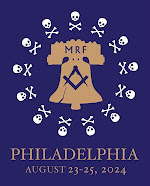There have been a few degrees conferred at rock quarries in and around New York this summer. I missed two recent Royal Arch events, but there also is a Craft lodge in Connecticut planning a MM° later this month. From the publicity:
 |
| Courtesy Moosup Lodge 113 AF&AM |
A Master Mason Degree performed in a real working stone quarry, under torchlight and set to resemble what may have been experienced in the time of King Solomon.
In the mid 1990s, there was an idea to confer a degree in a local stone quarry near Moosup. A brother at Moosup Lodge was the owner of a quarry, and asked if having an outdoor degree there interested the lodge. Begun in 1996 as an EA Degree, The Quarry Rite since has been performed a half dozen times as the MM Degree, and has been visited by brothers from the neighboring jurisdictions in New England, New York, and New Jersey, as well as by brothers from as far away as the Phillipines and Nova Scotia.
This year (August 19, 2017), We have reservations for four current Grand Masters to join us. The Quarry Rite is a one-of-a-kind degree performed outdoors, by torchlight, in an operative quarry. Under the stars, standard Connecticut ritual is augmented by soliloquies written specially for the event. Seating is unlimited, and reservations for the preceding cookout are necessary. Dress is extremely casual—this degree is in an operative quarry—bring a lawn chair and appropriate outdoor gear (hat, bug spray, water or soft drinks, and jacket).
- We ask that all who intend on joining us for the 4 p.m. cookout please RSVP here.
- There is no rain date for this event. Please visit this page in the days leading to the degree for notices regarding weather issues.
- We ask that alcohol not be brought into the quarry for obvious liability issues.
It has been more than fifteen years since I attended something like this, which took place near Harmony Lodge in northern New Jersey. I don’t think they do it any more, which is a shame, because it was a memorable and pleasant change of pace.
This one is out of my orbit, but York Temple Chapter 155 in Ohio will celebrate the tenth anniversary of its famous Mark Master cavern degree on Saturday the 19th with a conferral of the degree on Master Masons. Wish I could get there.













































































